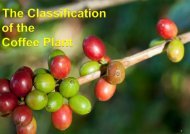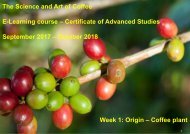You also want an ePaper? Increase the reach of your titles
YUMPU automatically turns print PDFs into web optimized ePapers that Google loves.
Plants are usually grouped in one genus based on common traits that justifies <strong>the</strong>ir close relationship within<br />
that group. The smallest scientific relevant group is a species. A species is by definition a group <strong>of</strong> natural<br />
populations, whose group members have <strong>the</strong> ability <strong>of</strong> reproduction, producing fertile <strong>of</strong>fspring. This is also<br />
called a reproductive community. If reproduction is no longer possible, e.g. in <strong>plant</strong>s by a change in <strong>the</strong><br />
flower morphology <strong>of</strong> an individual, this could be <strong>the</strong> basis to form a new species.<br />
However, always a combination <strong>of</strong> morphological traits are used in botanical classification. Closely related<br />
species do not necessarily resemble each o<strong>the</strong>r, but as long as <strong>the</strong>y share important traits, <strong>the</strong> relationship<br />
is easy to recognize. This also applies for C<strong>of</strong>fea, where not all species are looking similar, as some are<br />
very small trees, wheras o<strong>the</strong>rs are very large ones, which depends on <strong>the</strong> ecological niche <strong>the</strong>y exploit.<br />
Especially for genera <strong>of</strong> worldwide distribution, ecology is a far more relevant force to shape <strong>the</strong> <strong>plant</strong><br />
compared to its genetic heritage. For instance, Rubiaceae have many tree species in <strong>the</strong> (sub)tropics,<br />
whereas in <strong>the</strong> temperate regions <strong>the</strong>y are herbs in order to survive <strong>the</strong> winter as seed.<br />
This is an overview <strong>of</strong> <strong>the</strong> 125 species that are now forming <strong>the</strong> genus C<strong>of</strong>fea, which is also depicted in <strong>the</strong><br />
first part <strong>of</strong> all <strong>the</strong> latin names. The two relevant species in terms <strong>of</strong> c<strong>of</strong>fee production are C. arabica and C.<br />
canephora (marked in red). C<strong>of</strong>fea liberica is used only marginally for c<strong>of</strong>fee production, partly because <strong>of</strong><br />
its large beans. O<strong>the</strong>r species are grown only for local consumption, e.g. species on Madagascar.<br />
21








